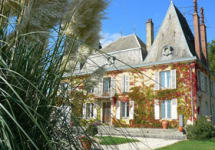Chateau Aydie Madiran Laplace 2013
-
Wine
Enthusiast


Product Details
Your Rating
Somm Note
Winemaker Notes
Professional Ratings
-
Wine Enthusiast
This celebration of Tannat is a balanced while severe and structured wine. Plenty of juicy fruit is ready to come out from behind the dry, tannic structure. There is power here as well in this wine that is firm and needs to age. Drink from 2019. Best Buy.


Tannat is the grape of Madiran, and it is not an easy-going varietal by any stretch. It is has thick skins, is very late-ripening and very tannic. It is hand-harvested because machine harvesters cannot shake these stubborn grapes off the vine, and typically needs a good amount of time to mellow out.

With hundreds of red grape varieties to choose from, winemakers have the freedom to create a virtually endless assortment of blended red wines. In many European regions, strict laws are in place determining the set of varieties that may be used, but in the New World, experimentation is permitted and encouraged resulting in a wide variety of red wine styles. Blending can be utilized to enhance balance or create complexity, lending different layers of flavors and aromas. For example, a red wine blend variety that creates a fruity and full-bodied wine would do well combined with one that is naturally high in acidity and tannins. Sometimes small amounts of a particular variety are added to boost color or aromatics. Blending can take place before or after fermentation, with the latter, more popular option giving more control to the winemaker over the final qualities of the wine.
How to Serve Red Wine
A common piece of advice is to serve red wine at “room temperature,” but this suggestion is imprecise. After all, room temperature in January is likely to be quite different than in August, even considering the possible effect of central heating and air conditioning systems. The proper temperature to aim for is 55° F to 60° F for lighter-bodied reds and 60° F to 65° F for fuller-bodied wines.
How Long Does Red Wine Last?
Once opened and re-corked, a bottle stored in a cool, dark environment (like your fridge) will stay fresh and nicely drinkable for a day or two. There are products available that can extend that period by a couple of days. As for unopened bottles, optimal storage means keeping them on their sides in a moderately humid environment at about 57° F. Red wines stored in this manner will stay good – and possibly improve – for anywhere from one year to multiple decades. Assessing how long to hold on to a bottle is a complicated science. If you are planning long-term storage of your reds, seek the advice of a wine professional.

Offering the perfect balance of quality and value, Southwest, France is a recognized appellation that encompasses all wine regions in France’s southwestern corner (except for Bordeaux and Cognac, which merit their very own). Two of the more famous subregions here are Cahors, known for its Malbec, and Madiran, home of the robust Tannat grape. Bordeaux Blends are also popular red wines of the Southwest; Petit Manseng is the regions’s star autochthonous white variety.
